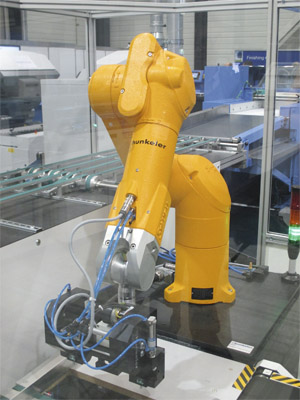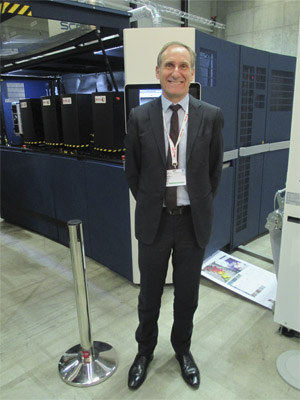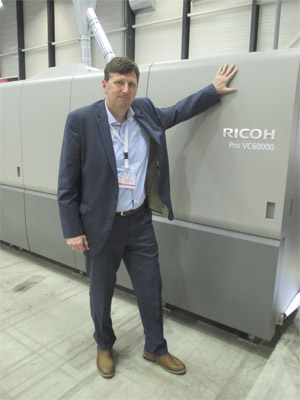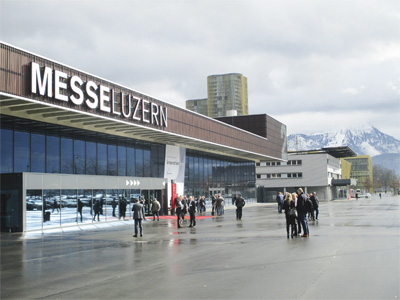The Messe Lucerne in Switzerland
This year the bi-annual Hunkeler Innovationdays attracted 6000 visitors and showcased the merits of digital inkjet to a newly interested party: commercial printers.
It might just be wishful thinking (or too many episodes of Game of Thrones) to imagine that the clouds encircling the summit of Mount Pilatus have been exhaled by its legendary dragons, but the stunning massif in Lucerne forms an impressive backdrop to the tradeshow that attracts visitors whatever the weather-during snowy conditions in 2003, visitors had to take a horse-drawn sleigh from Reiden to a nearby wool factory to see a press too big for its sports hall location. ‘Customers loved it!’ remembered Erwin Busselot, commercial print solutions director for production printing at Ricoh.
The 12th iteration of the bi-annual Hunkeler Innovationdays has grown considerably since the show was held near the Hunkeler factory and attendance could be counted in hundreds. Taking place from 20-23 February in the Messe Lucerne, this year the only snow was on the summit and the exhibitors’ wares were neatly contained in the venue’s two halls.
Size matters
New for 2017 was a layout that arranged all the machinery either side of one central corridor to accommodate the increased length of inkjet presses and inline finishing combinations. Providing 11,000 sqm of exhibition space (25% more space than in 2015), this is the optimum size for the show according to Stefan Hunkeler, who told Digital Printer, ‘We want to be as compact as possible. We don’t want to grow – we will try to do a copy/paste of this time [for 2019]; same style as this year.

Stefan Hunkeler plans to keep the 2019 event the same size
‘You will meet all the experts so that’s my limit – all the exhibitors and the vendors from a very high level are here, up to technicians who can speak to customers and management and everything in between. All is possible.’
There were 88 exhibitor stands in total for 2017, showcasing a broad range of machinery and collaborations, including Hunkeler’s two new partnerships with Horizon and Müller Martini.
The Hunkeler and Müller Martini Integrated system for inline book production demonstrated variable-format soft-cover book production in an inline procedure from the roll to the finished book. Production of the looseleaf book blocks took place on a roll-to-stack production system from Hunkeler. Subsequent perfect binding is done on a Vareo perfect binder and three-sided cutting on an InfiniTrim from Müller Martini. The system is designed for greatest possible efficiency on mini print runs right down to a run of just one and features robot technology to transfer the looseleaf book blocks to binder, explained Robin Brown, national sales manager, digital solutions division of Hunkeler distributor Friedheim.

New kid on the (book) block – Hunkeler’s robot made its debut
Courting commercial
Shrugging off the threat of an e-book challenge, book printing/assembling has always been a mainstay of the publishing industry, but Innovationdays is no longer the preserve of ‘the big book printers and the big transactional guys with big chequebooks,’ noted Kevin O’Donnell, marketing manager, graphic solutions at Xerox. ‘This time round, I’ve met lots of digital and commercial printers who are coming to look at inkjet technology for the first time because the profile and the quality and running costs are starting to impact on their marketplaces. I think what we’re seeing is a growing confidence in the commercial and digital printers in inkjet technology; it is becoming less formidable,’ he added.
Launched at the end of last year and now in employment, Xerox’s Trivor 2400 inkjet press was demonstrating the company’s ‘game changer’: high fusion ink, developed to address the challenge of printing directly onto offset coated stock without pre- or post-coating. The press is in operation at a European beta site (V Print, in Belgium), and Jean-Marc Pasturel, general manager of industrial inkjet sales, Xerox international operations, told Digital Printer: ‘We are planning to introduce Trivor and high fusion ink before the end of the year to other launches/deployment.’

Jean-Marc Pasturel, general manager of industrial inkjet sales, Xerox
Economic conditions will help accelerate the migration of offset printed volumes to inkjet, believes Mr Pasturel, with high fusion ink being the enabler of a “massive migration”. ‘We will probably double the volume of books printed in digital in the next 3-4 years because of inkjet,’ he predicted.
Having completed its separation into two companies, Xerox and Conduent, at the beginning of the year, the effects of the restructuring are now beginning to be felt. ‘We need to have the right fine tuning during the next few weeks but now the company is definitely focused in technology,’ explained Mr Pasturel. ‘This change is useful to become more flexible, more agile, because the market is changing extremely fast. We could speak about the colour book market, the magazines and catalogues application – and in the future about packaging. We need to be extremely reactive to the market change. This new structure of Xerox is helping [us] to adapt.’
Also showing new ink and seeking a slice of the direct mail and commercial print market was Screen, whose Jet520HD press was printing onto standard offset coated paper using the company’s new Truepress SC inkjet inks for the first time.
‘What we haven’t been able to do [until now] is sell to more commercial enterprises – people who print on glossy stocks,’ said Screen’s senior vice president of sales, Bui Burke. The new ink has a coagulation characteristic that stops it from spreading on glossy paper; it goes straight in a normal machine and is the same price as previous stock. ‘You can just put litho papers on a roll in front, and you can print beautiful quality direct through our machine,’ said Mr Burke, showing us some impressive sample calendars.
Launched two years ago, Ricoh’s VC60000 continuous feed inkjet press engine attracted attention from an unexpected source at the last Hunkeler Innovationdays. ‘We saw people glancing over the machine and we said “Hmm – why would they be interested?” because they were not the typical audience for this machine,’ revealed Erwin Busselot, recalling viewings by commercial printers in addition to transactional/direct mail companies.

Commercial interest – Erwin Busselot, commercial print solutions director for production printing at Ricoh
‘They were pleasantly surprised to see that this machine can give them the quality. Posters, calendars – not typically in the domain of inkjet. Customers in direct and transactional mail buy it because they want to increase quality; they also want to diversify what they are doing.’ Mr Busselot cited the example of in Hansaprint in Finland, which prints transactional in one shift and commercial in another, and a third shift
printing newspapers.
Data driven
On the Pitney Bowes stand, the company’s Epic 3.1 inserting system with unwinder was making a return after its debut at the show two years ago. ‘It’s why we’re back: for the right audience,’ said Grant Miller, chief operating officer, commenting on the popularity of the mail inserting system which can handle both small and large envelopes with a fully automatic set-up and a speedy 45-second changeover. ‘We’ve sold about 50 since we launched it,’ he added. ‘In this quarter alone we’re going to be
delivering 20.’
At the show the company announced an agreement with TagG and HP to develop a new native IPDS (Intelligent Printer Data Stream) controller for the Pitney Bowes IntelliJet and HP PageWide Web Press printing systems. ‘The IPDS controller will allow Pitney Bowes to offer an additional option for clients who desire to create higher value communications, or move to higher quality inkjet printing,’ said Jason Dies, president, Pitney Bowes document messaging technologies. The new controller will be sold and supported by Pitney Bowes and will be available globally beginning Q3 2017.
Round-up
With so much to pack into a couple of days, there was just time to dash around the Messe to see where the crowds were headed. Over on the Duplo stand, the company’s PFi DI-CUT 3000 on demand die cutter was ‘getting a lot of attention’, according to Joanne Punter, commercial manager. Canon was showing its new Océ ProStream press and Océ VarioPrint i300, with the latter producing material for a marketing campaign for Aston Martin by Hackett. Scodix was delighted to make its debut at the show, following a last-minute cancellation, and had a range of eye-catching print effects on display.
Böwe Systec’s Fusion Cross inserting system was shown being roll-fed using the UW6 unwind module from Hunkeler and with the new dual channel module to illustrate its design as a compact, economic alternative to roll on/roll off or multi-channel solutions. Combining a cut sheet with a continuous input channel, the system facilitates switching between applications or merging documents from both input channels for flexible and cost-effective production.
Over at KBA’s booth, the company was keen to explain the benefits of its RotaJET L-Series and VL-Series. All of the L-Series presses share the same hardware platform and can be upgraded on site from a mono system with a web width of 777 mm to four colour with a maximum web width of 1380 mm. The RotaJET L can print onto a wide range of substrates from lightweight stocks to carton board. The VL-Series of industrial inkjet presses covers webs widths from 1300 to 2250 mm, has a productivity rate of 18,000 sqm/hr and comes equipped with a décor package.
Overall, the message coming across this year was that digital is wooing more customers than ever before with its increased quality and versatility. Roll on 2019.
Read the full issue online here





